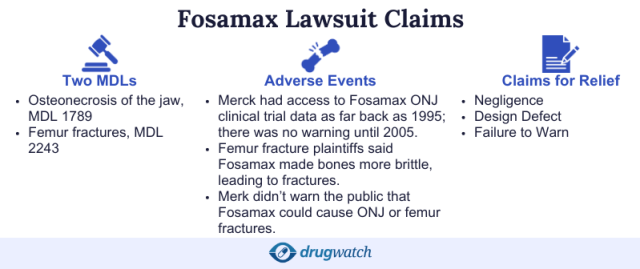Fosamax Lawsuits
Fosamax lawsuits against Merck claimed the drug caused osteonecrosis of the jaw (ONJ) and femur fractures. Allegations include failure to warn and manufacturing a defective drug. Merck settled 1,200 ONJ cases for $27.7 million, while a judge dismissed about 650 femur fracture cases.
Latest Fosamax Lawsuit Updates
As of September 2024, Fosamax litigation was winding down to a close. However, an appeals court revived more than 500 Fosamax fracture cases in Jew Jersey, and these plaintiffs will still have a chance to pursue litigation against Merck.
Fosamax (alendronate sodium) lawsuits included two multidistrict litigations and a multicounty litigation (MCL) focused on specific Fosamax side effects and injuries.
The first, MDL No. 1789, was formed in 2006 in the Southern District of New York for osteonecrosis of the jaw. It closed in 2018.
The second, MDL No. 2243, was formed in 2011 in the Trenton Division of the District Court of New Jersey for femur fractures. As of July 2024, one case remained out of the original 1,288 filed.
One New Jersey multicounty litigation for ONJ lawsuits remained active but close to closing. Our legal partners are no longer accepting claims.
Fosamax Lawsuit Timeline
-
September 2024
We have some good news to report for plaintiffs this month. A U.S. appeals court revived more than 500 Fosamax fracture lawsuits that had been previously dismissed. These cases were centralized in New Jersey federal court.
-
July 2024
Only one case remained open in the Fosamax MDL 2243 for femur fractures, but the MDL was practically closed. The next case management conference in the New Jersey ONJ MCL was scheduled for this month.
-
January 2024
The judge ordered plaintiffs’ attorneys to identify deceased clients who did not already appear on Case Management lists for the purposes of settlement proceedings for generic Fosamax defendants.
-
September 2023
Certain generic Fosamax defendants and plaintiffs reached a tentative settlement agreement in the New Jersey ONJ MCL. Plaintiffs who wanted to be included in the settlement had to notify the Plaintiffs’ Generic Settlement Liaison Counsel no later than 21 days following the entry of the judge’s order.
-
August 2023
The judge in the New Jersey Fosamax MCL for ONJ scheduled the latest Case Management Conference.
-
July 2023
Merck argued that 500 Fosamax cases that U.S. Judge Freda Wolfson had dismissed in appeal were rightly dismissed.
-
May 2023
Plaintiff appealed Judge Wolfson’s decision to dismiss 500 cases.
-
March 2022
Judge Wolfson dismissed more than 500 femur fracture injury claims in New Jersey based on federal preemption claims.
The MDLs included jury verdicts, dismissals and appeals. There was also one settlement for approximately 1,200 ONJ claims.
Lawsuits for Osteonecrosis of the Jaw
The now-closed MDL No. 1789 focused on Fosamax and jaw injuries, specifically osteonecrosis of the jaw. These were the first cases filed against Merck, and most attorneys, including our partners, are no longer taking cases. The cases were settled in 2013.
ONJ is a rare, severe bone disease that affects the jaw and typically happens after dental work, such as tooth extractions. Exposed bone crumbles and dies because of lack of blood, causing jaw problems. Senior U.S. District Judge John F. Keenan presided over these cases.
- Fosamax is defective because it may cause ONJ.
- Merck didn’t adequately warn plaintiffs and their doctors the drug could cause ONJ.
- Merck fraudulently concealed the risks of ONJ.
- Merck is guilty of negligence.
Studies in the lawsuits linked bisphosphonate drugs like Fosamax to ONJ. Doctors refer to ONJ associated with taking Fosamax as bisphosphonate-related osteonecrosis of the jaw.
Researchers theorize that Fosamax can cause ONJ because bisphosphonates make it difficult for bones to heal. Several plaintiffs in the MDL required multiple surgeries to restructure their jaws.
Plaintiffs say Merck knew as early as 1995 that Fosamax could cause ONJ, according to legal documents filed in Linda Secrest v. Merck. Yet, the company allegedly failed to investigate further or warn the public.

Merck received additional notice from reports from “over a hundred patients who had developed ‘dental pain’ and/or ‘dental infection’ during clinical trials in 1995.” The company also received several reports of “adverse oral outcomes” linked to Fosamax in the late 1990s, but Merck didn’t investigate further.
In October 2003, Merck received its first adverse event report expressly stating a Fosamax patient developed ONJ. According to Merck, its Adverse Event Review Team recommended adding a warning to the label in January 2005 after reviewing this and other reports.
Plaintiffs dispute this fact and say the AERT recommended a warning label for ONJ as early as January 2004. After the FDA sent a letter to Merck, the company placed a warning for ONJ on Fosamax in August 2005.
Lawsuits for Atypical Femur Fractures
MDL No. 2243 focused on atypical femur fractures allegedly linked to Fosamax. Plaintiffs sued Merck after taking Fosamax and experiencing femur fractures.
According to legal documents, Fosamax contributed to fractures by increasing the mineral density of bone. This makes bones thicker but not necessarily stronger because the drug inhibits the formation of new, healthy bones.
The process “does not necessarily correspond with reduction of fracture risk,” plaintiffs say. They contend it actually makes bone “highly mineralized, homogenous, brittle, and more susceptible to fracture.”
- Fosamax is defective because it may cause femur fractures.
- Merck didn’t adequately warn plaintiffs and their doctors that the drug could cause femur fractures.
- Merck was negligent in marketing and selling Fosamax.
- Merck breached its warranty.
- Merck committed fraudulent and negligent misrepresentation.
- Fraudulent and negligent misrepresentation
According to an appeal by Patrick Welch et al., Fosamax may linger in the body for several years after patients stop taking it, inhibiting new bone growth by as much as 50%.
“[Fosamax makes bone] “highly mineralized, homogenous, brittle, and more susceptible to fracture.”
Femur Fracture Lawsuit Dismissals
U.S. District Judge Joel A. Pisano presided over these cases before he retired. In 2014, he ruled in Merck’s favor, dismissing about 650 cases with injuries that occurred before Sept. 14, 2010.
Merck argued that the FDA would have rejected its label change for femur fractures. According to Judge Pisano, plaintiffs failed to show why their injury claims shouldn’t be dismissed on these grounds.
The plaintiffs in about 510 cases appealed to the Third Circuit Court of Appeals. In March 2017, the appeals court reversed Pisano’s order.
The panel found that a reasonable jury could conclude that the FDA only objected to use of the words “stress fracture” in the label because it was misleading. If Merck submitted a new label following the FDA’s suggestions, it could have been approved.

But in June 2018, the U.S. Supreme Court issued an order accepting Merck’s petition to consider its appeal of the Third Circuit’s ruling. Ultimately, in March 2022, Judge Freda Wolfson in New Jersey District Court ruled in favor of Merck and granted summary judgment in the MDL, ruling that the plaintiff’s failure to warn claims were preempted. The cases were then dismissed.
At one time, femur fracture lawsuits were pending in California state court. The first trial in California was conducted in 2015. Jurors sided with Merck. The verdict was upheld on appeal.
Another trial was scheduled for April 25, 2016, but was stayed at the plaintiffs’ request. The cases were dismissed because of preemption in 2017.
Jury Awards and Settlements
There have been few settlements or jury verdicts in Fosamax cases. Merck offered $27.7 million in 2013 to settle approximately 1,200 ONJ cases.
The $27.7 million settlement remains the largest in the Fosamax litigation. It doesn’t include femur fracture cases.
There have yet to be any settlements or jury awards for plaintiffs who claim that Fosamax caused femur fractures.
Shirley Boles
Shirley Boles took Fosamax from 1997 to 2006 and claimed the drug caused her to develop ONJ.
Trials:
The first trial ended in a mistrial because of a deadlocked jury, but U.S. District Judge John F. Keenan scheduled it for a retrial. During the retrial, Boles claimed negligence and strict liability for defective design.
Verdict:
In 2010, a New York jury awarded $8 million to Shirley Boles of Walton Beach, Florida. The judge later reduced the verdict to $1.5 million. Keenan also sanctioned Boles’ attorney, Gary Douglas, $2,500 for his conduct, which included calling Merck’s conduct “reprehensible” and “disgusting.” Boles refused to accept the reduced award and brought a third action against Merck, but the parties reached a settlement for an undisclosed amount before the case went to trial.
Rhoda E. Scheinberg
Rhoda E. Scheinberg took Fosamax from 2000 to 2006. After a tooth extraction in 2006, she developed ONJ.
Trial:
In the trial, Merck claimed Scheinberg’s ONJ developed because she had periodontal disease and diabetes and used other prescription drugs.
Verdict:
The New York jury awarded Scheinberg $285,000 and concluded that Merck failed to warn her or her doctor about the risk of ONJ. But it didn’t find that Merck defectively designed Fosamax. The award was for pain and suffering. The court previously dismissed Scheinberg’s punitive damages claim.
Calling this number connects you with a Drugwatch.com representative. We will direct you to one of our trusted legal partners for a free case review.
Drugwatch.com's trusted legal partners support the organization's mission to keep people safe from dangerous drugs and medical devices. For more information, visit our partners page.


